October 2, 2010
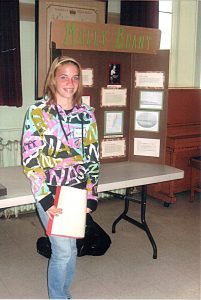 We were fortunate that Nicole Armitage of Glenburnie Public School could join us, bringing her display on “Molly Brant” which took one of the awards presented by Kingston Branch UELAC at the Kingston Regional Historica Fair, May 6-7, 2010. That was most appropriate for our meeting, since Molly Brant is presumed to be buried in an unmarked grave in St. Paul’s Churchyard, just outside our meeting place.
We were fortunate that Nicole Armitage of Glenburnie Public School could join us, bringing her display on “Molly Brant” which took one of the awards presented by Kingston Branch UELAC at the Kingston Regional Historica Fair, May 6-7, 2010. That was most appropriate for our meeting, since Molly Brant is presumed to be buried in an unmarked grave in St. Paul’s Churchyard, just outside our meeting place.
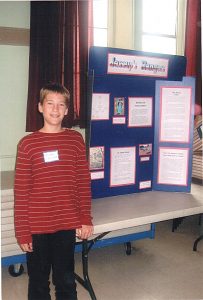 Members were pleased to see Brandon Elderhorst again, with his winning project on “Jessup’s Rangers”. Brandon, also from Glenburnie Public School, was the flag raiser on Loyalist Day, June 12, 2010.
Members were pleased to see Brandon Elderhorst again, with his winning project on “Jessup’s Rangers”. Brandon, also from Glenburnie Public School, was the flag raiser on Loyalist Day, June 12, 2010.
The speaker in October was Jo-Anne Lachapelle-Beyac, Curator of the MacLachlan Woodworking Museum, who told us about the origins of the museum and what it has to offer. The museum began with Sandy MacLachlan, for many years owner of a lumber yard and building supply company on Princess Street. He dismantled an 1853 log house, originally built by the White family in Lanark County, and moved it to his Princess Street site, where he operated a private museum in it displaying his collection of old woodworking tools. In the 1980s it was moved again to Grass Creek Park, highway 2 east. The museum is owned and operated by the City of Kingston. Over the years it has been developed to include five galleries including traditional logging, plane makers, a cabinet maker’s shop and a gift shop. In the summer there are programmes for families and children’s exhibit with pioneer costumes. The prized collection of over 11,000 tools for woodworking and related trades draws people from great distances to view some of the rarer pieces. Specifics of open hours and activities can always be found at the museum’s website www.woodworkingmuseum.ca/
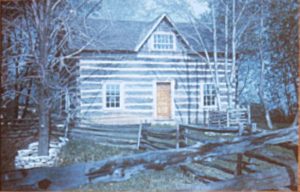
May 18, 2010
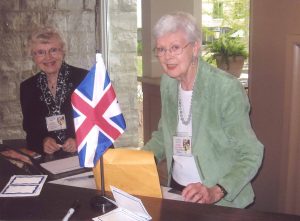 Audrey Bailey and Carol Davy welcome folks to the 2010 dinner meeting at the Donald Gordon Centre of Queen’s University.
Audrey Bailey and Carol Davy welcome folks to the 2010 dinner meeting at the Donald Gordon Centre of Queen’s University.
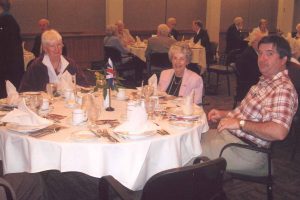
photos of May 18 courtesy of Peter Davy UE
The Donald Gordon Centre was an appropriate space in which to hear our speaker Carl Bray. The centre is built around Roselawn House, built in 1841 by David John Smith, a lawyer and son of Peter Smith, a pioneer merchant.
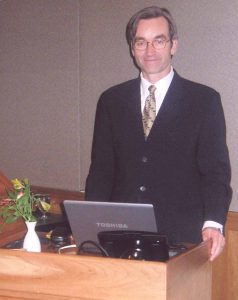
Dr. Bray is an adjunct professor in the School of Urban and Regional Planning at Queen’s University. He is also a heritage consultant: Bray Heritage is a heritage consulting firm specializing in the assessment, planning and development of cultural heritage resources.
Carl spoke on the topic of “A Legacy of Loyalist Architecture and Town Planning”. Once the Loyalists could abandon their first shelters in Upper Canada — tents and log cabins — they began building in the Georgian Classical tradition which led to symmetric and dignified structures: the “Ontario Farmhouse” as many are known today. The Loyalists’ architectural designs were distinct: not American, not British, but something quite unique.
January 23, 2010
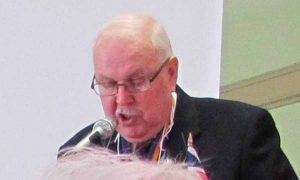
Left: Dean Taylor chairs his first meeting as president
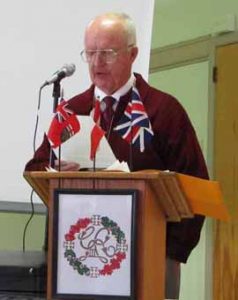
Right: Lynn Bell reports on Churchyard restoration funds
Our Loyalist ancestors likely pooled their food with others in order to make a meal, and we did too! After a delicious potluck lunch and a short business meeting, Professor John Fielding, Queen’s Faculty of Education, spoke on the topic “Loyalists and Immigration”.
He pointed out that the Loyalists represent the first group of refugees to arrive in Canada. Many more refugee groups followed: Irish famine immigrants, Scots who were victims of the enclosures, Home Children, Ukrainians, etc. We often forget that all these refugees arrived with virtually nothing, and had to rely on assistance from others as well as their own hard work in order to survive.
